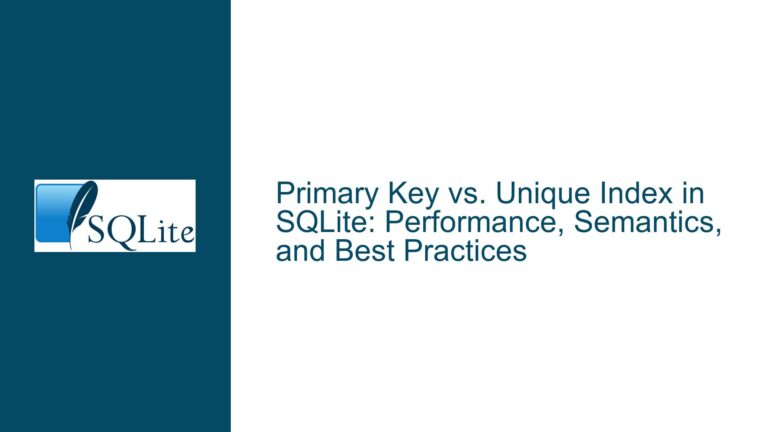Reusing Smallest Available IDs in SQLite Without AUTOINCREMENT
Efficiently Reclaiming Unused IDs in SQLite Tables
When working with SQLite databases, a common requirement is to maintain a compact set of unique identifiers (IDs) for rows in a table. Unlike the AUTOINCREMENT feature, which always generates the next highest integer, some use cases demand reusing the smallest available IDs to prevent unnecessary growth of the ID space. This is particularly important in scenarios where the ID range is limited or where minimizing the size of the database is critical. However, implementing this behavior efficiently, especially when dealing with batch inserts, can be challenging.
The core issue revolves around identifying and reclaiming the smallest unused IDs in a table while ensuring that the solution is both performant and scalable. The problem becomes more complex when new rows are inserted in batches, as the system must find multiple contiguous or non-contiguous unused IDs in a single operation. Additionally, the solution must avoid excessive table scans or temporary storage usage, which can degrade performance, especially in large tables.
Interrupted Write Operations Leading to Index Corruption
One of the primary challenges in reusing IDs is ensuring that the process does not inadvertently corrupt the database or violate referential integrity. When IDs are reused, there is a risk that old records referencing the reused IDs may still exist, leading to data inconsistencies. For example, if a record with ID 5 is deleted and its ID is reused for a new record, any remaining references to the old record with ID 5 will now point to the new record, causing logical errors.
Another potential issue arises from the complexity of the queries required to identify unused IDs. The initial approach involves scanning the entire table to find gaps in the ID sequence, which can be computationally expensive for large datasets. Furthermore, the recursive nature of some solutions, while elegant, may not scale well when dealing with millions of rows or when the gaps are sparse.
The use of temporary tables or additional data structures to track freed IDs, as suggested in some solutions, introduces its own set of challenges. While this approach can simplify the process of finding unused IDs, it requires careful management to ensure that the temporary data remains consistent with the main table. Additionally, the overhead of maintaining this auxiliary data must be weighed against the performance benefits it provides.
Implementing Recursive CTEs and Auxiliary Tables for ID Reuse
To address the challenges of reusing IDs efficiently, a combination of recursive Common Table Expressions (CTEs) and auxiliary tables can be employed. The recursive CTE approach allows for the identification of gaps in the ID sequence without requiring multiple table scans. By leveraging SQLite’s window functions and recursive query capabilities, it is possible to generate a list of candidate IDs that can be reused.
The following example demonstrates how to use a recursive CTE to find the smallest available IDs in a table:
WITH RECURSIVE result (newid) AS (
SELECT candidate FROM (
SELECT 1 AS candidate
WHERE candidate NOT IN (SELECT thingid FROM thing)
UNION ALL
SELECT thingid + 1 AS candidate FROM thing
WHERE candidate NOT IN (SELECT thingid FROM thing)
LIMIT ?1
UNION ALL
SELECT newid + 1 AS candidate FROM result
WHERE candidate NOT IN (SELECT thingid FROM thing)
ORDER BY candidate
LIMIT ?1
)
SELECT newid FROM result;
This query starts by checking if the smallest possible ID (1) is available. If not, it increments the ID and checks again, continuing until it finds an unused ID. The LIMIT ?1 clause ensures that the query stops after finding the required number of IDs. While this approach is effective, it can be optimized further by incorporating window functions to identify larger gaps in the ID sequence.
For scenarios where batch inserts are common, an auxiliary table can be used to track freed IDs. This table is populated by a trigger that fires whenever a record is deleted, adding the deleted ID to the auxiliary table. When new records are inserted, the system first checks the auxiliary table for available IDs before falling back to the recursive CTE approach. This hybrid solution reduces the computational overhead of finding unused IDs while ensuring that the ID space remains compact.
The following example illustrates the use of an auxiliary table and a trigger to manage freed IDs:
CREATE TABLE freed_ids (id INTEGER PRIMARY KEY);
CREATE TRIGGER track_freed_ids AFTER DELETE ON thing
BEGIN
INSERT INTO freed_ids (id) VALUES (OLD.thingid);
END;
-- When inserting new records, check the freed_ids table first
INSERT INTO thing (thingid, value)
SELECT id, ? FROM freed_ids LIMIT 1;
By combining these techniques, it is possible to create a robust and efficient system for reusing IDs in SQLite. The recursive CTE provides a flexible way to identify gaps in the ID sequence, while the auxiliary table ensures that freed IDs are reused promptly. Together, these approaches minimize the growth of the ID space and maintain the performance of the database, even as the number of rows increases.
In conclusion, reusing the smallest available IDs in SQLite requires careful consideration of both performance and data integrity. By leveraging recursive CTEs, window functions, and auxiliary tables, it is possible to implement a solution that meets these requirements while remaining scalable and efficient. Whether dealing with small datasets or large-scale applications, these techniques provide a solid foundation for managing ID reuse in SQLite databases.






